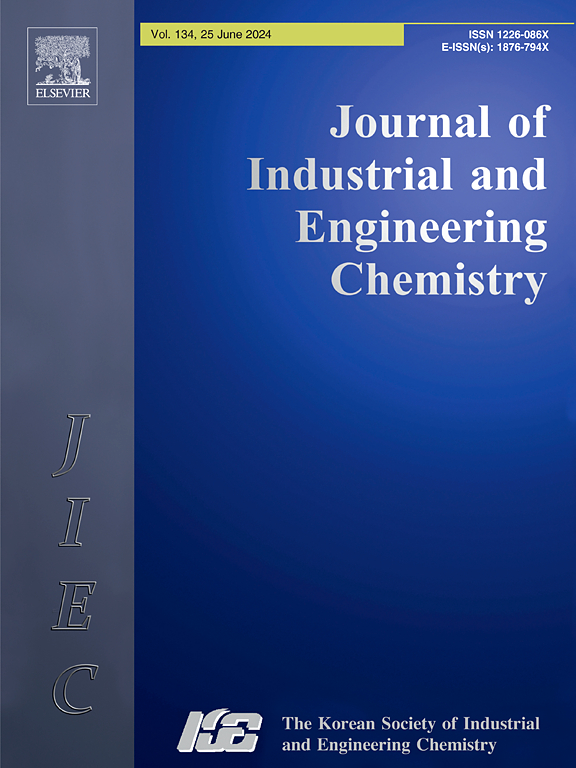磷酸法从磷矿废石中提取镁钙:热力学、参数优化、动力学及反应机理
IF 5.9
3区 工程技术
Q1 CHEMISTRY, MULTIDISCIPLINARY
Journal of Industrial and Engineering Chemistry
Pub Date : 2024-12-27
DOI:10.1016/j.jiec.2024.12.064
引用次数: 0
摘要
随着全球对磷基肥料需求的增加,磷矿开采导致了大量废石堆积,主要由白云石[CaMg(CO3)2]组成。这种富含白云石的废石(DRWR)既有环境风险,如地下水污染,也有生产有价值的磷酸钙和磷酸镁化合物的机会。本研究探讨了磷酸(PA)作为磷酸盐工业产品选择性浸出DRWR中的白云石以回收磷酸钙和磷酸镁的潜力。采用实验设计(DOE)方法,研究了影响浸出效率的因素,包括温度、PA浓度、粒径、酸引入方式、固液(S/L)比、反应时间和搅拌速度。热力学分析表明,PA与白云石的反应对温度敏感,最佳反应条件为44.97℃,3.07 mol/L PA, 47 min反应时间,S/L比为5.69/50 (g/mL)。动力学研究采用收缩核模型,测量了浸出温度(20-80°C)、搅拌速度(200-750 rpm)、粒径(- 90µm至600µm)和PA浓度(0.5-4.5 m)不同条件下的溶解速率,活化能为20.96 kJ/mol,表明产物层扩散控制机制。这些结果为开发可持续过程和促进磷酸盐工业的循环经济实践提供了有价值的见解。本文章由计算机程序翻译,如有差异,请以英文原文为准。

Magnesium and calcium extraction from phosphate mine waste rock using phosphoric acid: Thermodynamics, parameter optimization, kinetics, and reaction mechanism
With rising global demand for phosphate-based fertilizers, phosphate mining has led to significant waste rock accumulation, primarily consisting of dolomite [CaMg(CO3)2]. This dolomite-rich waste rock (DRWR) presents both environmental risks, such as groundwater contamination, and opportunities for producing valuable calcium and magnesium phosphate compounds. This study explores the potential of phosphoric acid (PA), a phosphate industry product, for selectively leaching dolomite from DRWR to recover calcium and magnesium phosphates. Using a design of experiments (DOE) methodology, the research examines factors affecting leaching efficiency, including temperature, PA concentration, particle size, acid introduction method, solid–liquid (S/L) ratio, reaction time, and stirring speed. Thermodynamic analysis revealed that PA selectively reacted with dolomite in a temperature-sensitive manner, with optimal conditions identified as 44.97 °C, 3.07 mol/L PA, 47 min reaction time, and a S/L ratio of 5.69/50 (g/mL) using a Box-Behnken design. Kinetic studies, employing the shrinking core model, measured the dissolution rate across various conditions—leaching temperature (20–80 °C), stirrer speed (200–750 rpm), particle size (−90 µm to 600 µm), and PA concentration (0.5–4.5 M). An activation energy of 20.96 kJ/mol suggests a product layer diffusion-controlled mechanism. These results provide valuable insights for developing sustainable processes, and promoting circular economy practices in the phosphate industry.
求助全文
通过发布文献求助,成功后即可免费获取论文全文。
去求助
来源期刊
CiteScore
10.40
自引率
6.60%
发文量
639
审稿时长
29 days
期刊介绍:
Journal of Industrial and Engineering Chemistry is published monthly in English by the Korean Society of Industrial and Engineering Chemistry. JIEC brings together multidisciplinary interests in one journal and is to disseminate information on all aspects of research and development in industrial and engineering chemistry. Contributions in the form of research articles, short communications, notes and reviews are considered for publication. The editors welcome original contributions that have not been and are not to be published elsewhere. Instruction to authors and a manuscript submissions form are printed at the end of each issue. Bulk reprints of individual articles can be ordered. This publication is partially supported by Korea Research Foundation and the Korean Federation of Science and Technology Societies.

 求助内容:
求助内容: 应助结果提醒方式:
应助结果提醒方式:


